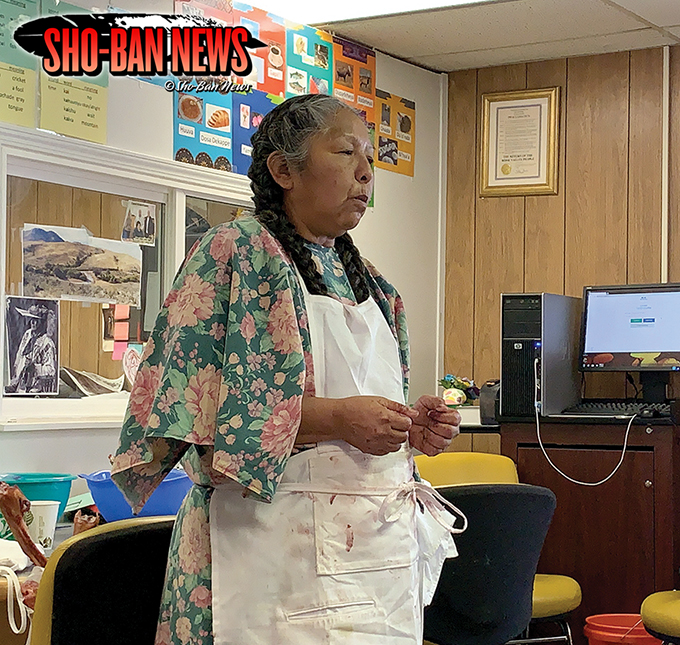Wahtomy shares harvest & preserving plant knowledge

Charlene Wahtomy
By DANA HERNANDEZ
Sho-Ban News
FORT HALL — The Language and Culture Preservation Department hosted another Zoom session for the Virtual Youth and Elder Gatherings and Drive-Thru Dinners on Friday, April 9.
The session was part of many that encourages the youth and elders to take part of the Tribal Practices for Wellness in Indian Country grant by listening to speakers who share their traditional knowledge and tribal practices regarding wellness. This session featured tribal elder Charlene Wahtomy who spoke about her knowledge of harvesting and preserving the plants used for food and medicine.
At the beginning of the session, Louise Dixey the Language and Cultural Resource Director shared a presentation from Carolyn Smith, which discussed the Shoshone-Bannock gathering rights and resources. Gathering, in the presentation, was described as a spiritual enrichment that is protected by the 1868 Fort Bridger Treaty, 1978 American Indian Religious Freedom Act and the 1993 Religious Freedom Restoration Act.
The presentation went over how plants were used for food, clothing, shelter, and practices, which means, taking only what is needed and saving the rest for future use. Also, how travel was dependent on the seasons because they had to know where to go for various resources and how to preserve food in order to prevent waste. Traditional foods were discussed in the presentation first, and one food that the Shoshone and Bannock highly depended on were roots. Roots are said to be the main staple to our diets. In order to gather roots, appropriate tools were needed and used for digging. Preservation methods of roots were passed down with each generation.
Plants were equally important and were dried and used for winter food. Back then, holes were dug in the ground to hold the winter food because the ground was cold enough to preserve. Holes were also used to store food for the spring.
The message from the presentation was that, the consumption of traditional foods can help a person be healthy as compared to fast food which is convenient. Advice from the presentation was that our people need to eat less processed foods.
The presentation described our current knowledge, limited because we only know so much about the plants our ancestors used. Some well-known foods that we know were gathered were the Yamba, a wild carrot that can be eaten fresh, cooked or dried for winter, and also prevents and controls diabetes. Bitterroot and wild turnips were also gathered, as well as sunflower seeds that were cleaned, dried and stored. Berries were a nutritious staple to our diets and were eaten fresh and stored by drying or freezing. Berries could be eaten with meats or as a dessert. There are many different types of berries: chokecherry, serviceberry, currant, rose, raspberry, elderberry, buffaloberry. Some berries were not local and required us to travel in order to gather.
Mint, sweet sage, and cattails are used for sundance, and cattail roots could be consumed. Also, used for sundance were cottonwood. Other trees, like juniper and cedar were used for ceremonial purposes. Minerals were gathered and used for paints and spiritual purposes. Obsidian and antlers were also sought and gathered for tools.
The presentation also educated participants on the non-edible and poisonous plants: poison ivy, poison oak, water hemlock, stinging nettle, mushrooms, and death camas, which are the white flowers that grow along with the purple camas flowers. “People need to know where the plants are and how to gather them,” said Dixey.
Advice to the participants, learn your tribal history and homelands. Eat more natural foods and native foods, also learn to prepare and process them. Don’t always take the root when gathering, cut from the surface. Replace soil when digging the holes. If it’s your first kill or taking, it should be given away. Leave an offering when taking, it shows respect and the next time there will be more.
Guest speaker, Charlene Wahtomy spoke about water and said back then, the chiefs chose places that had good access to water. “We’re born from water, and our water blesses us,” said Wahtomy.
For the presentation, Wahtomy had prepared some chokecherries and shared how she did it. Wahtomy said when the chokecherries are gathered, she dries them and when she wants to use them, she puts them in a boiling pot of water and cooks it slow.
“When cooking with food, take your time. When you want something to be good you use your mind and heart. It’s like beadwork. Be good with yourself and have clean hands when cooking,” said Wahtomy.
She also shared how she does her dried meat. Wahtomy said she cuts her meat into strips, which she hangs and said she will pound it down until it becomes soft. Dried meat is usually used for elders and babies.
Wahtomy also brought camas that had begun to grow at home. She said her camas was still able to grow without any dirt. She showed participants what her dried bitterroot looked like. She had pine nuts and demonstrated how winnowing baskets were used to roast the pine nuts. She said hot coals were added to the baskets and as the basket was shaken the wind would blow out the pine shells. Also shown was “dosa”, which she said she completely dried and uses it for medicine. Doza can be boiled with sage and can be used for pain.
Wahtomy said, “when we’re done gathering all our foods we pray for them. Understand that you only take what you need, so the next person can use it too. Food and medicine are meant to take care of your body and your soul.”





